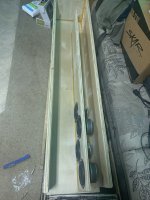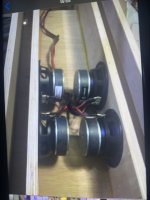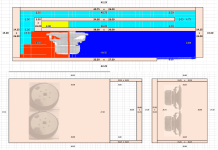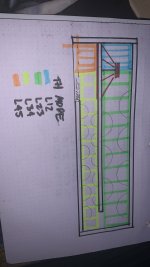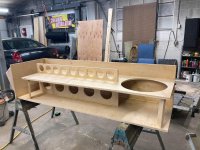David,Hi BP,
Could you please advise what version or product number of Hornresp was used to produce the screen shown in the attachment.
Thanks,
David
im using the below
Version 50.70.
I don't like flat responses for BP's in 2Pi. Once you apply the low pass filter and place the enclosure in a corner or vehicle, the low end is boosted too much, hence "1 note bass."
I don't like flat responses for BP's in 2Pi. Once you apply the low pass filter and place the enclosure in a corner or vehicle, the low end is boosted too much, hence "1 note bass."
Hilarious, I just posted my version in the HR Manual thread!Hi BP,
Could you please advise what version or product number of Hornresp was used to produce the screen shown in the attachment.
Thanks,
David
TBH, I wasn't smart, educated enough to do other than believe in/follow the pioneer's (especially Bell Labs') extensive experience, so while Altec was known to use up to 12:1, experimented with up to 20:1 to find that Altec's was on the 'bleeding edge' according to my female listening group once critically damped, so max long term chose 10:1.What does GM think about the high compression ratio And air velocity in 335 cm2 by chance?
Without damping, never tried > the pioneer's 1:1.2561 max compression horn aspect ratio once any boundary conditions are accounted for, so can only assume/recommend HR's calculations and/or one's ears at the spec'd pi listening distance.
Last edited:
Kinda interesting here: mass loaded (tapered) TL in series with a TL 🤓BP1
on your wide cabinet i made S5 smaller for some more low extension
is that feasible ?
View attachment 1152062
View attachment 1152065
I think I hear/feel this too sometimes.Version 50.70.
I don't like flat responses for BP's in 2Pi. Once you apply the low pass filter and place the enclosure in a corner or vehicle, the low end is boosted too much, hence "1 note bass."
That S5 makes a HUGE difference!
David,
im using the below
Thanks maxolini.
Product number 5460-230306 should work just fine, so I am guessing that the Hornresp input screen you show in Post #83 was copied from elsewhere (presumably generated using an older version of Hornresp) and that the screen shown was not actually produced by you. Is this correct?
Post #83: https://www.diyaudio.com/community/threads/dual-skar12-paraflex-c-cram.395528/page-5#post-7286418
Kind regards,
David
Version 50.70.
Thanks BP.
That explains it then 🙂.
The S2S, S3S and S4S designations were not added until Version 51.00:
Post #11,147: https://www.diyaudio.com/community/threads/hornresp.119854/page-558#post-6354168
It's about time you found a way to update your old copy of Hornresp! A number of useful new features have been added since Version 50.70 was released.
Kind regards,
David
Attachments
Yes , it was BP1 😝Thanks maxolini.
Product number 5460-230306 should work just fine, so I am guessing that the Hornresp input screen you show in Post #83 was copied from elsewhere (presumably generated using an older version of Hornresp) and that the screen shown was not actually produced by you. Is this correct?
Post #83: https://www.diyaudio.com/community/threads/dual-skar12-paraflex-c-cram.395528/page-5#post-7286418
Kind regards,
David
I can't. It's a work laptop. I rarely use my home laptop. Shoot, I'm about to log onto my work laptop now.It's about time you found a way to update your old copy of Hornresp! A number of useful new features have been added since Version 50.70 was released.
Kind regards,
David
I ‘built’ a diy example/Proof to oneself of BP1s muddy/overwhelming bottom end type of sound experience and it ‘can’ be a bit bloated if you’re sitting against the wall or absolutely if you’re in the car.
at the same time, this helps in reinforce infrasonic tones( IMHO ), and is amazing down that low where things are felt more than ‘heard’ ? So there’s that application sometimes.
left is the ‘tapped pipe’ and right is the ‘ paraflex’ folded appropriately at ’identical ‘ 3:1’ segments. Apples to apples as this is the same drivers and box volume. things then are obvious here and starts to show what everyone needs to know/experience in all if this IMHO to make real discussions on higher order ’qw pipes’
at the same time, this helps in reinforce infrasonic tones( IMHO ), and is amazing down that low where things are felt more than ‘heard’ ? So there’s that application sometimes.
left is the ‘tapped pipe’ and right is the ‘ paraflex’ folded appropriately at ’identical ‘ 3:1’ segments. Apples to apples as this is the same drivers and box volume. things then are obvious here and starts to show what everyone needs to know/experience in all if this IMHO to make real discussions on higher order ’qw pipes’
Attachments
Last edited:
Only thing of those cabinets is that they skinny and long, not easily stacked or to pack in a pickup
They are ‘skinny’ because of the small ‘VAS and Qes‘ requirement. It’s an illusion that scales away with ‘larger‘ drivers and their TS parameters affectively.
80 cm x 3 is 240 cm(36 hz) and 80 cm x1 (proper TL spacing in parallel ‘exactly’) is 108 hz. They aren’t ‘long and skinny’ in reality. But they appear that way with small 100cm2 and 200cm2 required by the drivers (Sd is 50cm2) in this scenario.
the other is 240 cm total (120cm twice)
32 or 48” respectively. the wavelengths dont change, these aren’t actually ‘long and skinny’ once you use the drivers your referring to ? (400-500 and 800-1000cm2 stepped for the ddx12 paired, for example)
80 cm x 3 is 240 cm(36 hz) and 80 cm x1 (proper TL spacing in parallel ‘exactly’) is 108 hz. They aren’t ‘long and skinny’ in reality. But they appear that way with small 100cm2 and 200cm2 required by the drivers (Sd is 50cm2) in this scenario.
the other is 240 cm total (120cm twice)
32 or 48” respectively. the wavelengths dont change, these aren’t actually ‘long and skinny’ once you use the drivers your referring to ? (400-500 and 800-1000cm2 stepped for the ddx12 paired, for example)
Last edited:
Guys,
can somebody paint in color for S1, S2, S3 ,S4 and S5
cant figure it out by myself.

can somebody paint in color for S1, S2, S3 ,S4 and S5
cant figure it out by myself.
- Home
- Loudspeakers
- Subwoofers
- Dual Skar12 paraflex C CRAM
